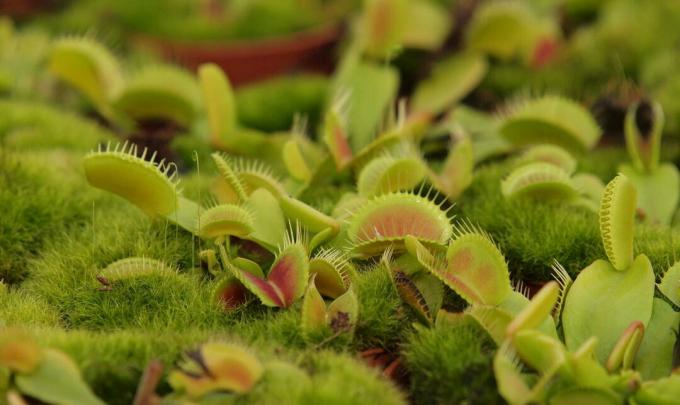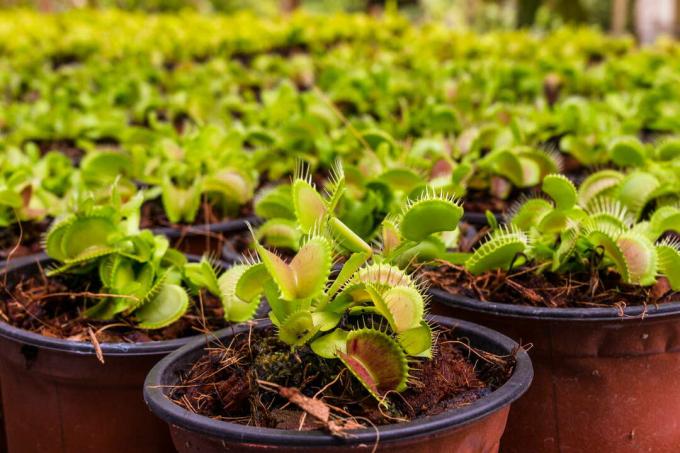The carnivorous Venus flytrap can self-propagate by harvesting its seeds. We show how to multiply the carnivore yourself.

the Venus Flytrap (Dionaea muscipula) can be propagated in two ways: First, you can use the self-harvested seeds of the Sow light-germinating exotics, on the other hand, the carnivorous plant can also be divided by division multiply. We explain step by step how you have to proceed so that the multiplication is crowned with success.
contents
- Venus Flytrap Seeds: Pollination and Seed Maturity
- Venus Flytrap Seeds: Harvesting and Storage
- Sow venus flytrap seeds
- Multiply Venus Flytrap by dividing it
- Venus flytrap: care after propagation
Venus Flytrap Seeds: Pollination and Seed Maturity
the Flower of the Venus flytrap is only of secondary importance for many and sometimes even annoying. Most of the time, the flower stalks are cut off shortly after budding in order to channel all of the growth energy into the catch leaves. However, in order to harvest your own seeds, you do not have to separate the flowers. The flowers develop in early spring at the end of the approximately 30 cm long flower stalks and mature by the end of April at the latest.
In order for seeds to form at all, the flower must of course be pollinated. In enclosed spaces, pollinating insects tend to be the exception. To be on the safe side, you can use a fine brush to help out by using Carefully tap the stamens of the Venus flytrap and so the pollen on the pistils reach.

Venus Flytrap Seeds: Harvesting and Storage
The ripe seeds are very fine and deep black. If the flower has dried up, you can assume that the seeds are also ripe. There are several ways you can harvest the seeds. On the one hand, you can cut off the dried flowers and carefully tap them into a bowl to get to the seeds, or You wait for the seeds to loosen naturally and simply place a bowl under the ripe flower to collect. Alternatively, you can tie a bag around the dried inflorescence to catch the ripe seeds.
Important: It takes almost nine months until the seeds are re-sown. It is therefore particularly important that you store the seeds correctly in order to maintain their ability to germinate. A dark, cool and above all dry place is ideal for this.

Sow venus flytrap seeds
The right time to sow the seeds is in early spring. Prepare one or more small pots with a substrate for this. In contrast to adult plants, the seedlings still need nutrients from the substrate, so that you can use commercially available sowing substrate for cultivation. Later, however, you should move your Venus flytrap into special carnivore soil. Moisten the substrate in the pot well and press it very carefully. Then sprinkle some seeds superficially on the substrate. The seeds do not need a top layer of soil, as the Venus flytrap is a light germ. After 20 to 30 days, the seeds will begin to germinate. Wait until the seedlings are about 2 cm tall before pricking the plants. When pricking out the small Venus flytraps, you can move two to three plants into a new pot.

tip: Put a transparent and perforated bag over the plant pots and place the well-watered seeds in a warm and sunny place. The plastic bag has the same effect as a greenhouse and helps to maintain a high level of humidity. Even after pricking, the mini greenhouse helps the small Venus flytraps to establish themselves quickly and quickly grow into voracious plants. However, the film should only be used as an aid for as long as necessary and for as short as possible, as it encourages the spread of harmful fungal infections.
Multiply Venus Flytrap by dividing it
In addition to propagation by seeds, you can also propagate your Venus flytrap by division. This is possible because the plant also reproduces through shoot axes (rhizomes) that run underground and sprout again and again. To do this, carefully remove the plant and its root ball from the pot. You can separate the rhizome by gently plucking it or with a pair of scissors and thus obtain viable new plants. When separating, make sure that there is (at least) one shoot or stem as well as enough roots on a "new" plant. The small plants are then placed in new pots filled with plant substrate, just like when pricking out. After transplanting, you should place the plant in a warm and sunny place so that the small Venus flytraps can quickly establish themselves.

Venus flytrap: care after propagation
After you have successfully propagated your Venus flytrap, you can use various care measures to help ensure that your darlings continue to find the best conditions. The North American exotic makes certain demands on irrigation water, plant substrate and insists on being repotted regularly. Special treatment during the winter months is also extremely important so that your Venus flytrap can also show its best side in the following year.
In order to offer the new Venus flytrap the best possible start in life, you should attach particular importance to a suitable plant substrate. As bog plants, Venus flytraps prefer a soil with a stable and balanced water balance and a low pH value. Too many nutrients, on the other hand, are a horror for them - ideally the substrate in which they are planted should therefore be low in nutrients. Carnivore soil, like that Floragard special soil for carnivorous plants, fulfills these requirements perfectly and is therefore the first choice if you want to multiply Venus flytraps.
Read more about the topic here Pour Venus Flytrap and get many more great tips about Caring for your venus flytrap.

